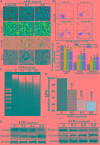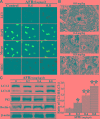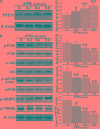Induction of mitochondria-mediated apoptosis and PI3K/Akt/ mTOR-mediated autophagy by aflatoxin B2 in hepatocytes of broilers
- PMID: 27863407
- PMCID: PMC5356714
- DOI: 10.18632/oncotarget.13356
Induction of mitochondria-mediated apoptosis and PI3K/Akt/ mTOR-mediated autophagy by aflatoxin B2 in hepatocytes of broilers
Abstract
Aflatoxins have been shown to induce hepatotoxicity in animal models, but the effects of aflatoxin B2 (AFB2) on broiler hepatocytes is unclear. This study aimed to investigate the effects of AFB2 on apoptosis and autophagy to provide an experimental basis for understanding the mechanism of aflatoxin-induced hepatotoxicity. One hundred-twenty Cobb500 broilers were allocated to four groups and exposed to 0 mg/kg, 0.2 mg/kg, 0.4 mg/kg, and 0.8 mg/kg of AFB2 per day for 21 d. AFB2 exerted potent proapoptotic and proautophagic effects on hepatocytes, with increased numbers of apoptotic and autophagic hepatocytes.Poly ADP-ribose polymerase (PARP) was cleaved and caspase-3 was activated in experimental groups, showing that the apoptosis of hepatocytes was triggered by AFB2. Increased levels of the autophagy factors Beclin-1 and LC3-II/LC3-I, as well as down-regulation of p62, a marker of autophagic flux, provided additional evidence for AFB2-triggered autophagy. AFB2 induced mitochondria-mediated apoptosis via the production of reactive oxygen species (ROS) and promotion of the translocation of Bax and cytochrome c (cyt c) between mitochondria and the cytosol, triggering the formation of apoptosomes. AFB2 also inhibited the phosphoinositide 3-kinase/Akt/mammalian target of rapamycin (PI3K/Akt/mTOR) pathway by activating PI3K, Akt, and mTOR and inhibiting their phosphorylation, contributing to the proautophagic activity of AFB2. These findings provide new insights into the mechanisms involved in AFB2-induced hepatotoxicity in broilers.
Keywords: PI3K/Akt/mTOR-mediated autophagy; aflatoxin B2; broiler; hepatocytes; mitochondria-mediated apoptosis.
Conflict of interest statement
The authors declare that they have no conflicts of interest.
Figures




References
-
- Cea J. Update on worldwide regulations for mycotoxins. The Mercosur harmonization of limits on mycotoxins with the international regulations. Innotec. 2011.
-
- Maurice O. Mycotoxins in Agriculture and Food Safety. Int J Food Sci Tech. 2000;35:354–355.
-
- Galvano F, Ritieni A, Piva G, Pietri A, Diaz DE. MYCOTOXINS IN THE HUMAN FOOD CHAIN. Mycotoxins Blue Book. 2005. pp. 187–224.
-
- Raisuddin S, Singh KP, Zaidi SI, Paul BN, Ray PK. Immunosuppressive effects of aflatoxin in growing rats. Mycopathologia. 1993;124:189–194. - PubMed
-
- Dugyala RR, Sharma RP. The effect of aflatoxin B1 on cytokine mRNA and corresponding protein levels in peritoneal macrophages and splenic lymphocytes. Int J Immunopharmaco. 1996;18:599–608. - PubMed
MeSH terms
Substances
LinkOut - more resources
Full Text Sources
Other Literature Sources
Research Materials
Miscellaneous

